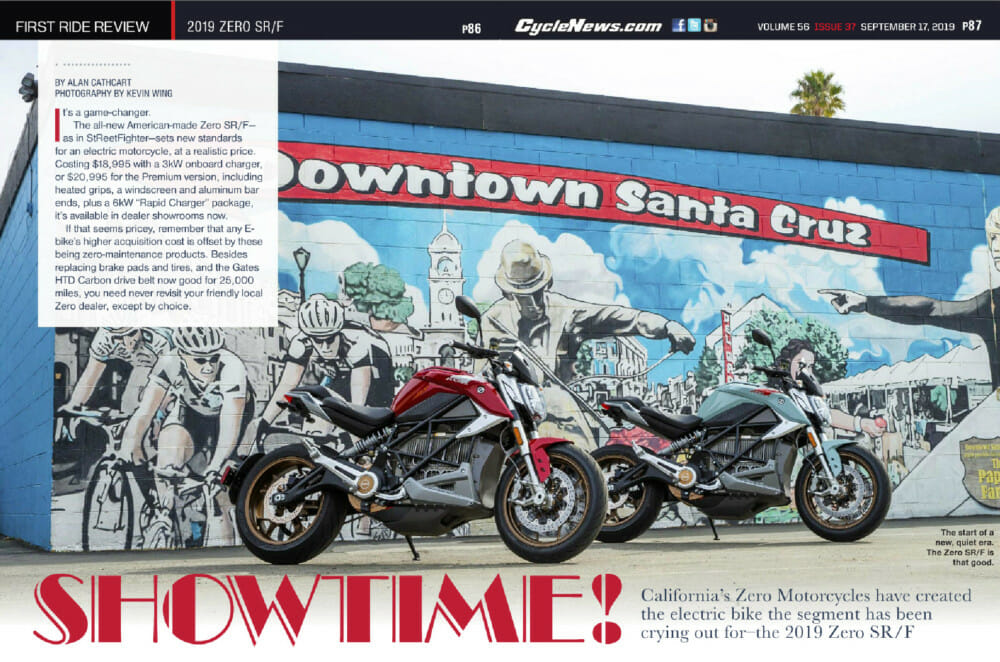Alan Cathcart | September 22, 2019
California’s Zero Motorcycles have created the electric bike the segment has been crying out for in the 2019 Zero SR/F.
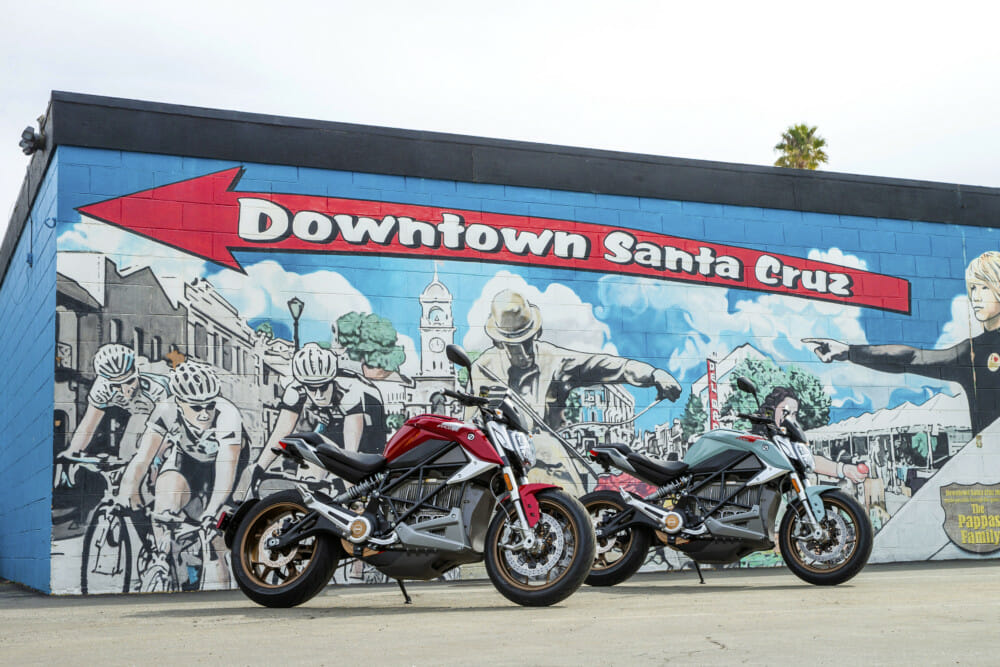 The start of a new, quiet era. The Zero SR/F is that good.
The start of a new, quiet era. The Zero SR/F is that good.
Photography by Kevin Wing
It’s a game-changer.
The all-new American-made Zero SR/F—as in StReetFighter—sets new standards for an electric motorcycle, at a realistic price. Costing $18,995 with a 3kW onboard charger, or $20,995 for the Premium version, including heated grips, a windscreen and aluminum bar ends, plus a 6kW “Rapid Charger” package, it’s available in dealer showrooms now.
If that seems pricey, remember that any E-bike’s higher acquisition cost is offset by these being zero-maintenance products. Besides replacing brake pads and tires, and the Gates HTD Carbon drive belt now good for 25,000 miles, you need never revisit your friendly local Zero dealer, except by choice.
Essentially, it’s taken $250 million of venture capital invested over the past 11 years by Zero’s owner, NYC-based Invus Group, to get Zero this far. But after spending two days riding the SR/F for around 170 miles in every kind of situation on the demanding roads of Northern California, it’s clear it is indeed finally showtime for a real-world sportbike that’s intoxicating to ride, but just happens to be powered by an electric motor, not an I.C.E., or internal combustion engine.
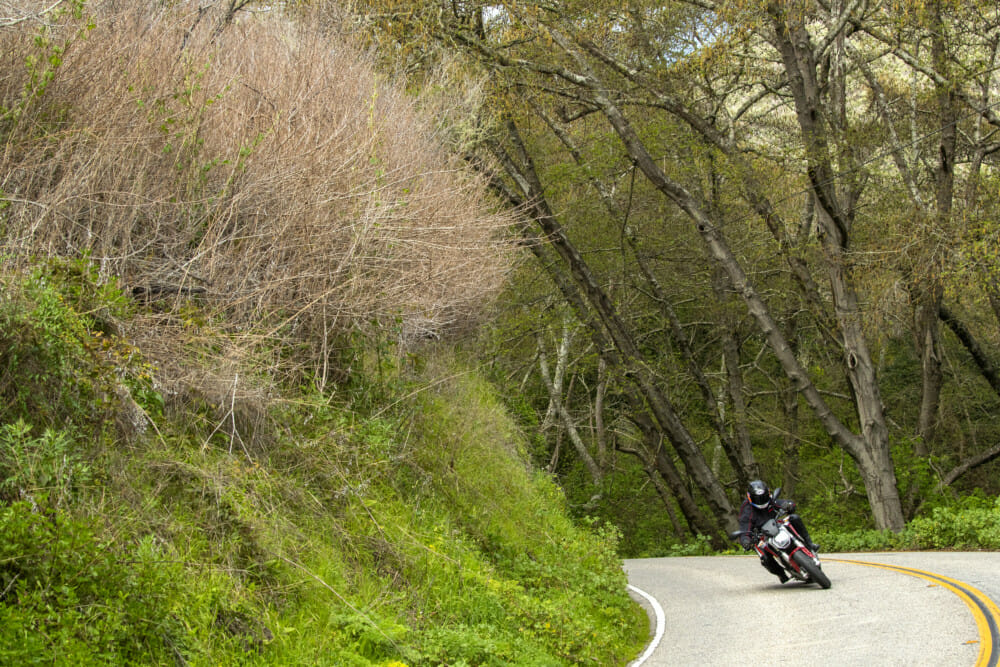 Range is claimed at 161 miles in city use, but adding a Power Tank will increase this to over 200 miles.
Range is claimed at 161 miles in city use, but adding a Power Tank will increase this to over 200 miles.
Why so? Until now there’s been one significant drawback to deter anyone who rides bikes for fun from Going Electric. Besides range anxiety and recharging time issues, there have always been too many inherent compromises in E-bike design to make them genuine rivals to conventional bikes. Running on skinny tires to increase range via reduced drag, or downsizing on brakes to lower weight.
And then there’s been the styling—dorky-looking is a way of describing the many aesthetically challenged E-bikes in the marketplace, looking more like an assembly of parts than a single unified design. Unless you really wanted to contribute to saving the planet, there’s been no real incentive to buy electric. Until now.
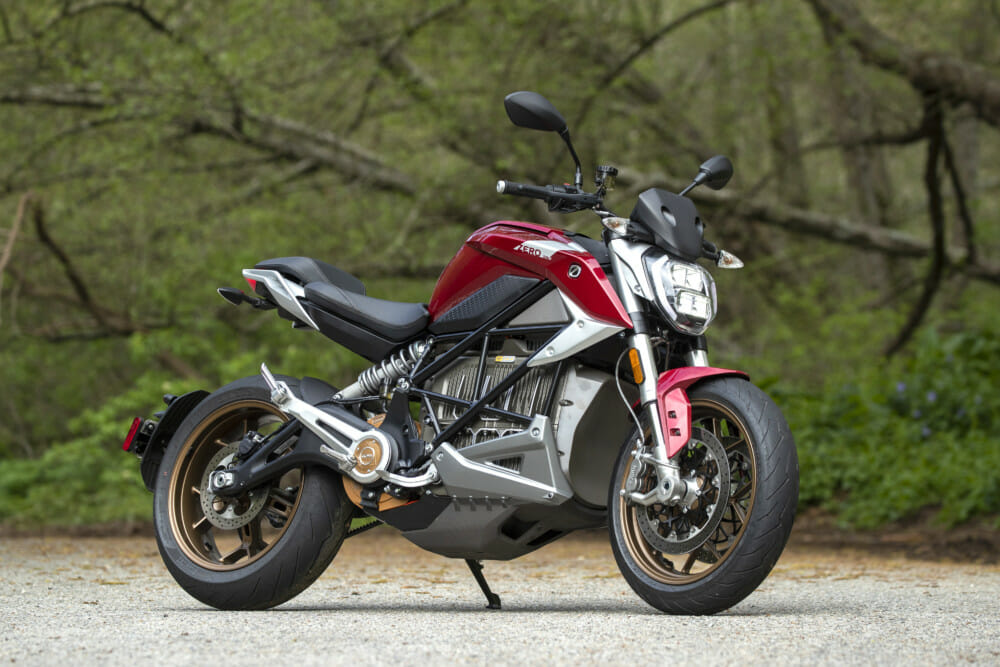 The SR/F was modeled on the need for a Euro-style naked bike. The styling clearly worked.
The SR/F was modeled on the need for a Euro-style naked bike. The styling clearly worked.
Testing the 2019 Zero SF/R
Slide aboard the 31-inch high seat that’s 0.8 inches lower than before, and you’ll discover a more welcoming riding position than on any previous Zero. The SR/F feels much more substantial than the outgoing SR, yet you feel a real part of it, and this more integrated stance will give extra confidence to less experienced riders.
Thanks to the spacious seat design that’s usefully narrowed where it meets the “tank,” at 5’10” tall I could not only put both feet flat on the ground at rest but also move around easily on the go. You’re not wedged in place at all, plus the SR/F seems well balanced despite its relatively high weight. The taper-section aluminum handlebar delivers a slightly leaned forward riding stance, which is definitely sporty yet totally comfortable, and not at all tiring. This bike feels incredibly taut and very together when you ride it.
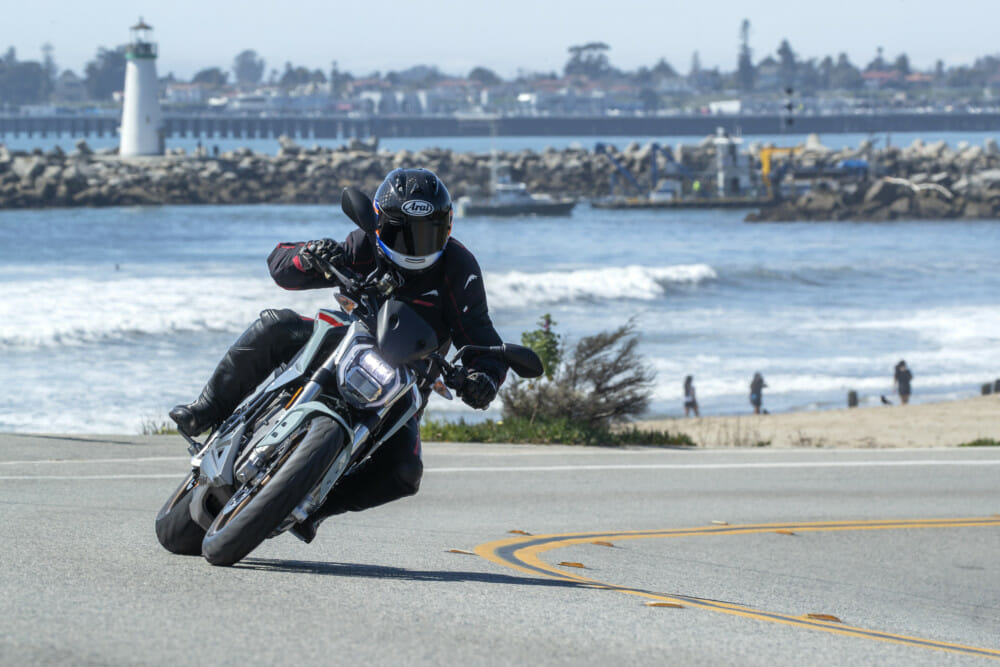 Zero’s worked tremendously hard to make a motorcycle that corners like a regular machine.
Zero’s worked tremendously hard to make a motorcycle that corners like a regular machine.
I spent a good part of my second day aboard the SR/F on a series of high-speed pursuits of Zero test rider Trevor Doniak, and what he doesn’t know about riding in the Redwood forests of the Santa Cruz Mountains hasn’t been invented. I found the performance of the new Zero to be absolutely intoxicating, with the kind of muscular acceleration I was already well familiar with after riding each successive year’s new Zero model since 2012—and then some. This is a huge step up from even last year’s SR, let alone the Zero DSR I made a six-day 920-mile tour of Northern California on in 2016.
Sure, the more powerful new motor plays a vital role here, but it’s that seamless yet controlled delivery of the massive torque available as soon as you open the throttle, that’s so invigorating. Sorry, Ducati—but this is a Monster 1200 on steroids, that’s much easier to ride for the simple reason that you’re always in the right gear, and don’t have to work your left hand or foot at any time.
Moreover, Zero has made the SR/F super controllable via the choice of distinct riding modes now on offer, even if I didn’t, fortunately, have to worry about Rain, and wasn’t concerned about getting home, so didn’t use Eco. Returning to base after 85 miles of hard, hard riding saw 12 percent of charge still in the “tank” after a brief 30-minute top-up when we stopped for lunch.
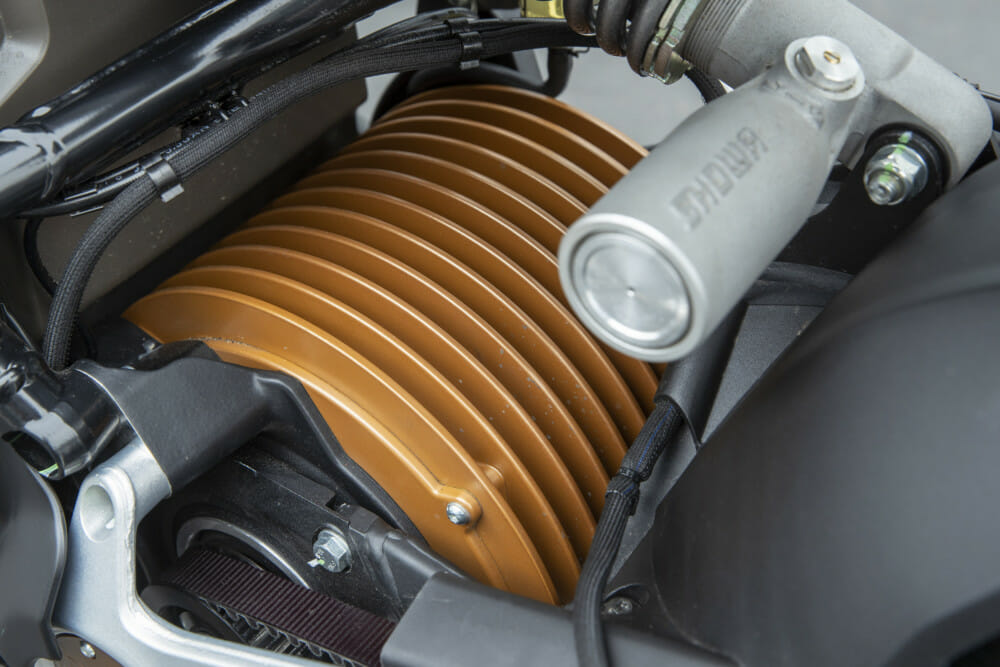 The AC motor is well packaged, helping keep the center of gravity low.
The AC motor is well packaged, helping keep the center of gravity low.
The Politics of Regen
The most noticeable difference between Sport and Street modes is how the regenerative braking is triggered when you roll off the throttle. In Sport mode, the regen doesn’t kick in until the throttle’s just a few degrees from fully closed. This permits a more precise regen application and allows you to get back on the throttle harder. In Street mode, proportional regen takes over several degrees on the twistgrip away from having the throttle completely closed, and as the grip gets closer to the full off position, the regen increases, albeit progressively, delivering what amounts to engine braking which the rider can modulate as the situation requires. The only trade-off is that when rolling on the throttle again, the initial acceleration isn’t as snappy.
However, I found that descending a twisty hillside road in Sport mode, it was hard to keep up the flow because the regen kept slowing the bike quite abruptly as I closed the throttle for a turn. Okay, you say, adjust the regen—but the only way to do this on the Zero is to get on your cellphone and do it through the app. That’s impractical! I want to be able to alter it quickly and easily now via a switch on the ‘bar, just as I can on BMW’s C evolution E-maxi scooter, and I think Askenazi & Co.—who seemed genuinely surprised I would ask for this—have missed something here that I hope they’ll rectify in future versions of the bike.
Okay, I can switch to Street to have less intrusive regen, but then I sacrifice the more immediate hit of maximum torque I want when I get on the throttle again to drive out of the turn, often uphill.
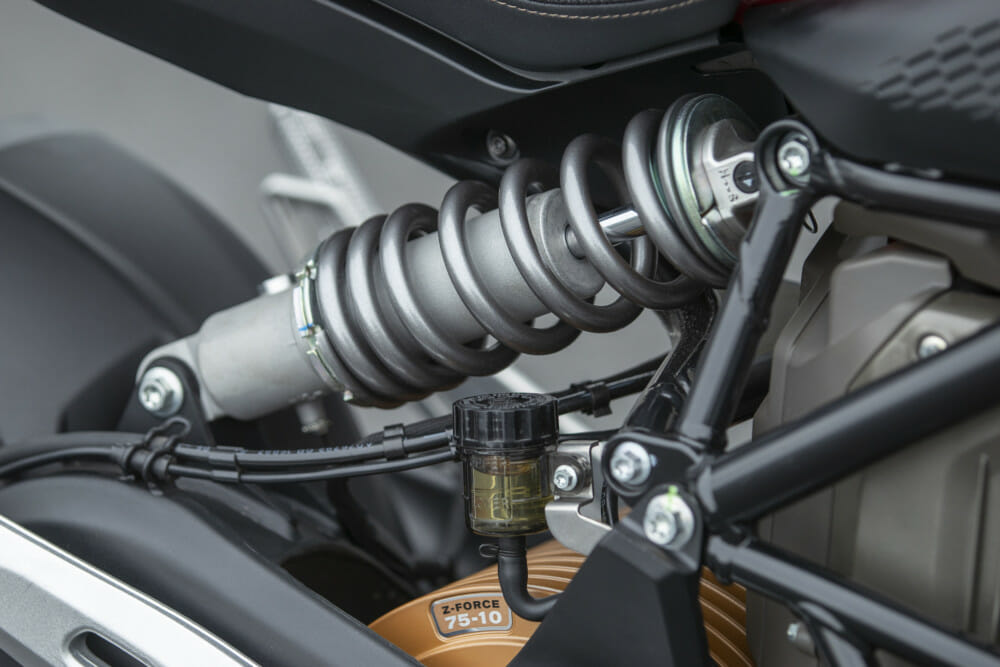 Fully adjustable suspension front and rear for the SR/F.
Fully adjustable suspension front and rear for the SR/F.
Born Well
But it’s a mark of how successfully Askenazi & Co. have re-invented the street-legal E-bike that that’s all I found to complain about in my two days aboard the SR/F. Besides the truly mind-blowing acceleration, its high-speed handling was deeply impressive, too, tracking straight and true on a short blast up to the 124 mph indicated top speed, and delivering a confidence-inspiring sense of being truly planted as I flicked it from one side to another through successive 80 mph sweepers running through the Redwood forests.
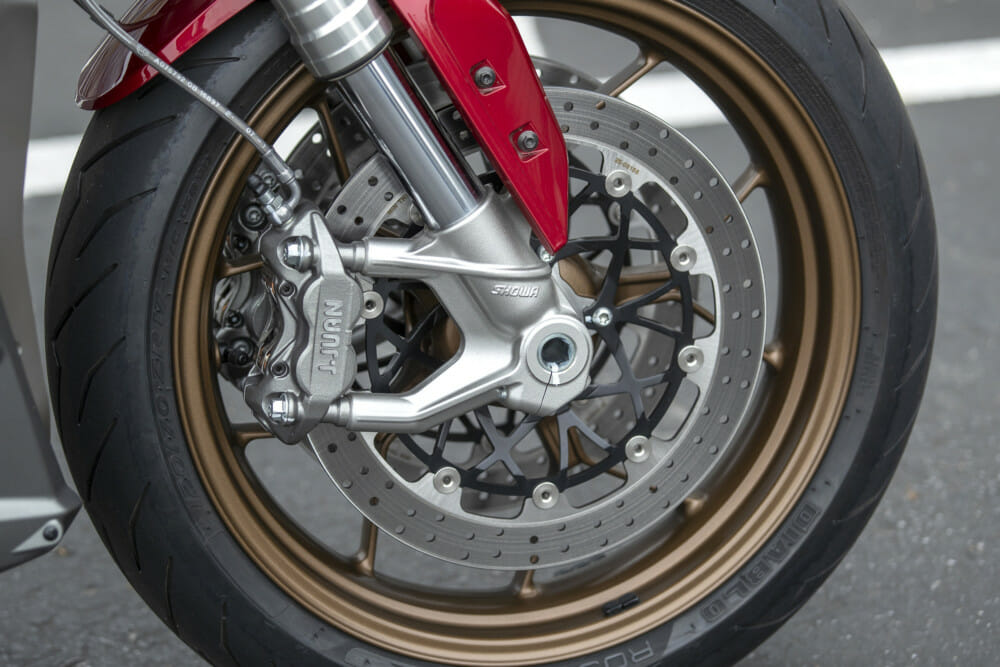 The four-piston J. Juan calipers are impressive in their performance, especially given they don’t produce four-piston calipers for many machines.
The four-piston J. Juan calipers are impressive in their performance, especially given they don’t produce four-piston calipers for many machines.
Just as on an RBW/ride-by-wire I.C.E. bike the SR/F’s top speed is limited by software, so there’s no fall-off in power before the limit’s reached, and nor is there any fierce cutout. You simply arrive at an indicated 124 mph and stay there, with just the wind rustling in your ears as you waft along on a magic carpet ride that’s slightly uncanny the first time you experience it—the quite pleasant, futuristic whine that’s the only sound you hear from the SR/F at lower speeds, is banished at high speed by the wind.
The SR/F is most at home on a twisting hillside road, where the motor’s formidable torque delivery and capable, confidence-inspiring handling, making it the king of the road. The J.Juan brakes deliver fabulous stopping power, with heaps of feel. The Pirelli tires are a sound choice, too—aside from offering outstanding grip (and the Zero’s massive torque was a stern test of how well the rear Diablo Rosso III hooked up), they’re lighter than their rivals, so they contribute to that impressive acceleration via reduced rotational inertia. And neither trail braking nor grabbing a handful of front brake mid-corner would deflect the SR/F from its chosen line. Its handling is very forgiving.
I can immodestly claim to have ridden more different electric motorcycles—not scooters—than anyone else on this planet, including each Isle of Man Zero TT race-winner, and the current holder of the E-bike Land Speed Record, as well as a huge variety of street-legal E-models produced over the past decade in Europe and the USA.
The Zero SR/F is the best production electric motorcycle I’ve yet ridden, and it sets a new benchmark for others to aim at. Zero has produced an E-bike for which no excuses are in order, which delivers intoxicating performance coupled with inherent practicality, that’s ready to be compared on equal terms dynamically with any equivalent combustion-engined bike.
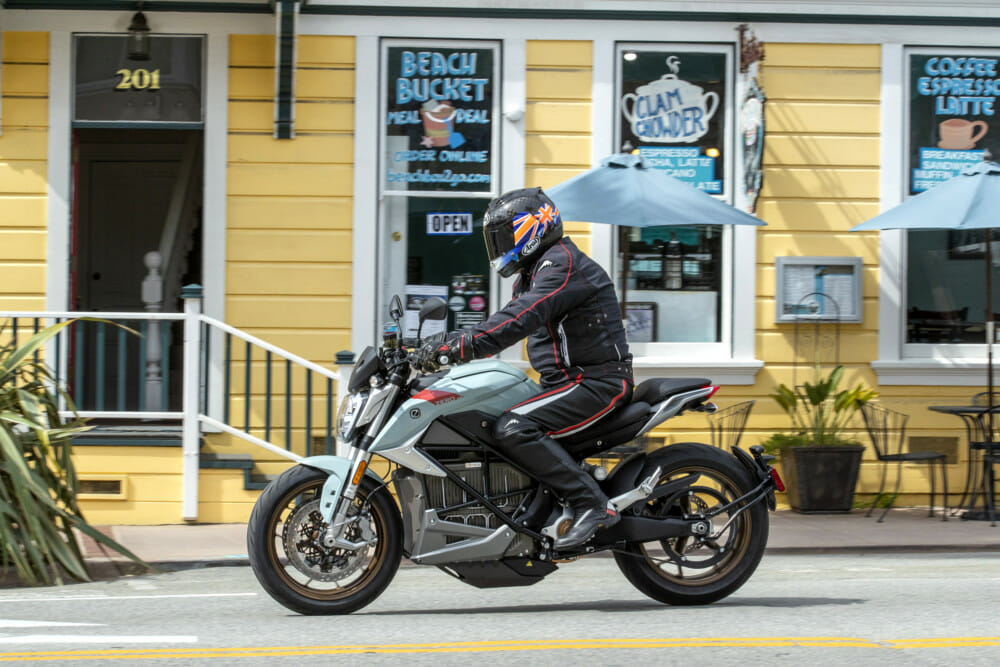 Gliding through Santa Cruz. Oddly, you get more looks from pedestrians than if you had a loud pipe.
Gliding through Santa Cruz. Oddly, you get more looks from pedestrians than if you had a loud pipe.
Starting from (almost) Zero
It’s logical that it should be California-based Zero Motorcycles which has finally smashed this barrier down, because it essentially invented the electric motorcycle a decade ago with the 2009 Zero S—the first series production E-bike ever.
Until now, Zero has focused on producing ever more capable versions of that original model, with more power and torque, greater range and reduced recharging times. The fact that Europe has now overtaken the USA in the company’s sales charts confirmed that Zero’s decision 30 months ago to recast its lead model as a muscular-looking European-style naked hotrod ready to appeal to global customers, with performance and handling to match its looks, was the right call.
“If riding electric is a transformational experience in feeling more connected to the environment owing to the lack of noise and other issues, we wanted to make sure this motorcycle did that on steroids!” says Zero’s CTO/Chief Technical Officer Abe Askenazi, who over the past decade has been responsible for driving the steep development curve Zero’s products have followed since he came on board in 2010, after being CTO at Buell. “What does the F in SR/F stand for? Okay, mostly for Fighter, but you could also say that it’s fast, it’s furious, and it’s fun—there’s a lot of “F” words that describe it!”
To create that vision, Askenazi & Co. started from almost zero (sorry!)—fewer than 10 percent of the components employed in the company’s previous range-topping SR model made it to the new one. The battery box containing the lithium-ion pouch cells that’s at the heart of the motorcycle both visually and dynamically has been totally redesigned, its cast aluminum structure gaining vertical fins to assist cooling when it’s re-charging (and thus stationary). Zero’s Director of Industrial Design, Matt Bentley, and his three-man team have produced an appealing design in which form follows function, the same as the bike as a whole—it’s no coincidence the SR/F was the first Zero model to be created via a clay model, after Bentley & Co. combined 3D-printed chassis and motor components with clay sculpting to produce a full-size model for fine-tuning.
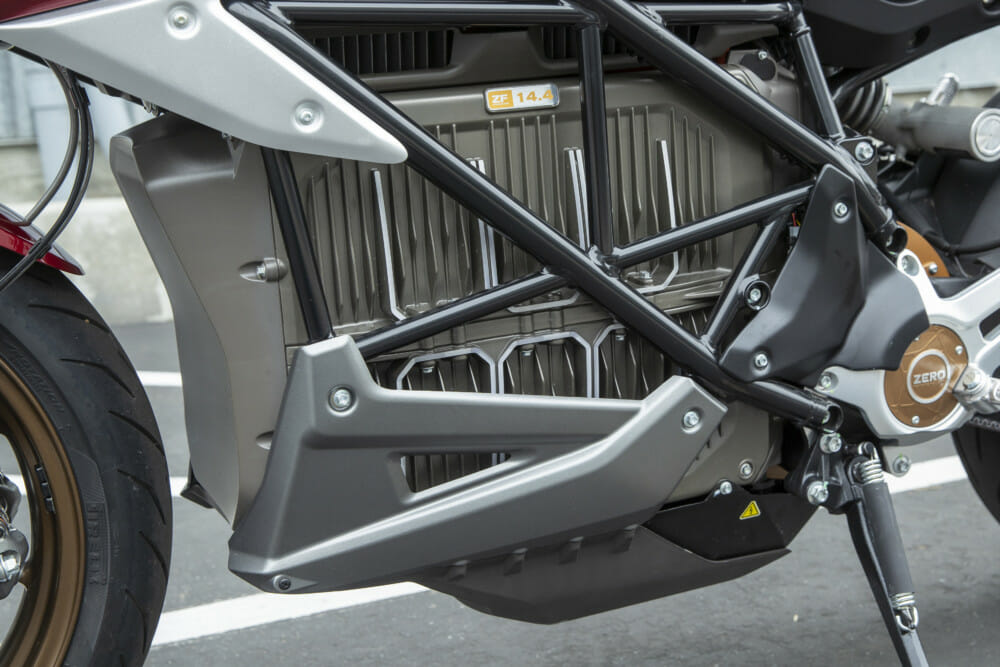
2019 Zero SR/F Power Unit
The SR/F’s ZF75-10 brushless Z-Force AC motor created in-house represents a significant upgrade to the previous design. This is a radial flux sealed motor, whereby the permanent interior magnets are located on the single moving part, i.e., the rotor, while the components which get hottest—the windings, aka coils—are mounted on its periphery, whence the heat can be dissipated via a deeply finned circular aluminum housing. This means there’s no bulky, heavy liquid cooling, since the motor is passively air-cooled, hence there’s no fan, although the Bentley boys’ refined styling does feature a chin fairing that funnels air beneath the battery box to the motor positioned in the swingarm pivot, and the controller mounted in front of it, to provide additional cooling. The SR/F’s version of the motor is 30mm wider than before, which of itself produces more power—110bhp/82kW at 5,000 rpm, and a constant 140ft-lb of torque from 1 rpm onwards. That’s quite some increase from the 70bhp/52kW and 116lb-ft delivered by the previous SR’s ZF75-7R motor, so the SR/F is the first Zero model to produce more than 100 bhp. Top speed has also risen commensurately to a claimed 124 mph (from 102 mph on the SR) thanks not just to the extra power from the motor, but also a 1,000 rpm increase in peak revs to 7,500 rpm.
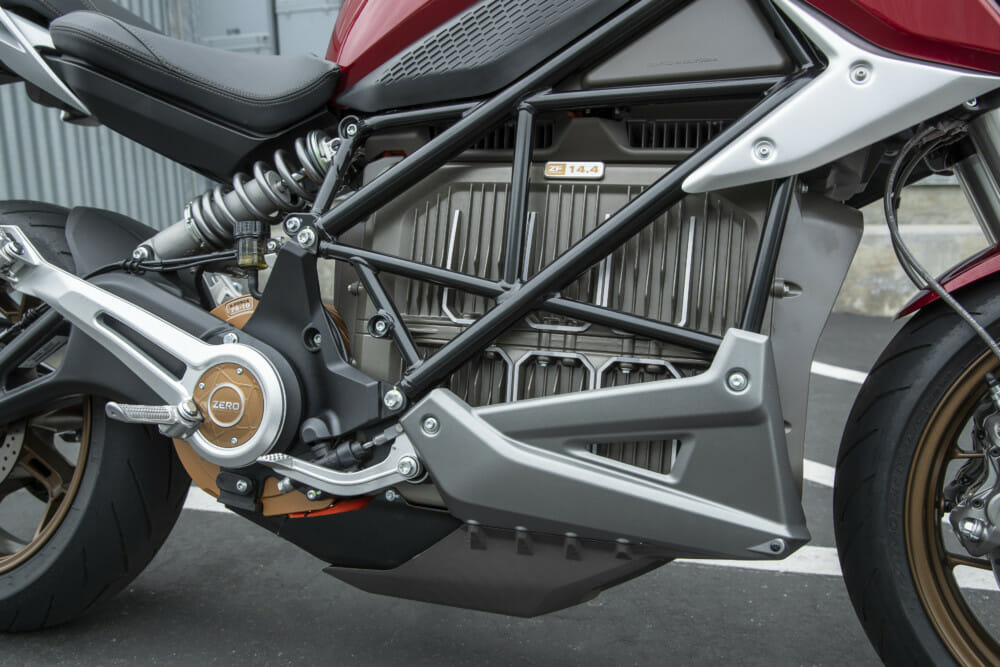
2019 Zero SR/F Frame
Wrapped around the battery pack which it uses as a fully-stressed component is a triangulated tubular steel spaceframe worthy of any Ducati, bolted to cast-aluminum plates which each comprise the outer housing of the twin-sided swingarm. This is made from two halves of pressed steel welded together to form an ultra-sturdy structure – that massive hit of torque delivered by the new Zero motor all through the rev range was too much for an aluminum structure to support, says Askenazi. That’s why the swingarm pivots on a 100mm diameter oil-impregnated sintered bronze plain bearing, to tie everything in tight to create a massively solid integrated swingarm pivot which encircles the motor’s drive shaft in a coaxial arrangement which none other than Massimo Tamburini pioneered on his first-generation Bimota designs, and for the same reason – constant chain tension for him, and a constant drive belt tension on the SR/F.
Termed the Power Pivot by Zero, this coaxial format permits a very high belt tension to eliminate any drivetrain lash, as well as to promote long belt life. The fully adjustable cantilever Showa shock sits offset to the right and delivers 140mm of travel to the cast aluminum rear wheel. Its 5.50-inch rim carries a 180/55-17 Pirelli Diablo Rossi III tire that’s far larger than anything Zero has used before—last year’s SR range-topper carried a 130/80-17 Pirelli MT-01 on its 3.50-inch rear wheel. It’s the same up front, where the 43mm Big Piston Showa SFF fork, which is again fully adjustable with 120mm of travel, carries a 120/70-17 Diablo Rosso III on a 3.50-inch wheel, where last year the SR had a 3.00-inch front rim and a 110/70-17 tire.
Brakes are provided by J.Juan, with their front four-piston calipers doubled up and radially mounted via special Showa fork lowers produced exclusively for Zero, and bite upsized 320mm floating discs, with a 240mm rear disc and single-piston floating caliper. The need for the uprated brake package is evident when you check out the SR/F’s claimed weight: 485 pounds for the standard SR/F, and 498 pounds for the Premium, with its bigger charger. This is a lot heavier than the outgoing 2018 SR with the same battery and charger at 414 pounds, thanks to the upscale brakes, suspension, tires/wheels, and other chassis hardware. There’s indeed a weight differential between the Zero SR/F and comparable rival ICE streetfighters like the 461-pound Ducati Monster 1200—but the American E-Rod more than makes up for that in how it delivers its performance, thanks to its huge 140 ft-lb dose of constant torque, compared to the Ducati’s 87 ft-lb that’s positively wimpish by comparison.
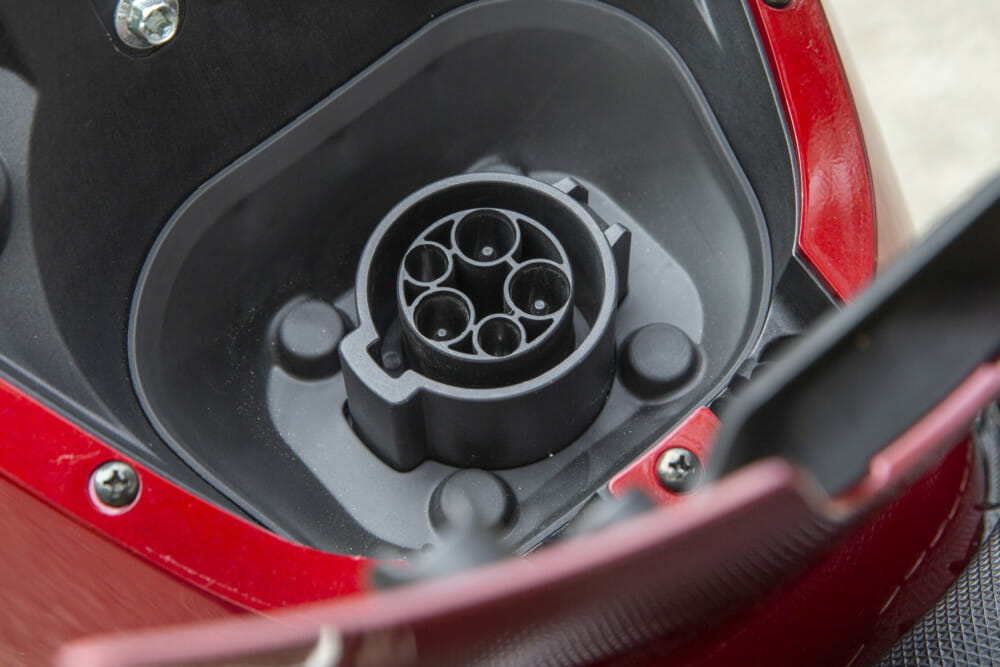
2019 Zero SR/F Charging
Unlike on the more expensive Harley-Davidson LiveWire which is presently its principal competitor, the Zero SR/F includes integrated Level 2 charging as standard, while offering two more powerful Level 2 charging options, one of which is included as standard on the costlier Premium version. The 3kW Level 2 charger in the standard SR/F will recharge the bike’s 100V ZF14.4 lithium-ion battery from 0-95 percent in four hours (note the last five percent of charging takes around half an hour, to balance out all the cells).
The Zero also comes with an adapter for 110V household power (i.e., Level 1 charging) to the Level 2 plug, so overnight charging at off-peak rates is feasible, taking eight hours for 0-95 percent recharging.
The SR/F Premium model has a 6kW charger as standard, essentially halving the charge time again, to two hours for 0-95 percent capacity. Additionally, an updated Power Tank will be available later this year to offer an additional 6kW of capacity, bringing the total to 12kW and allowing a 0-95 percent charge in just an hour, with a full charge 30 minutes longer.
However, the charging station must be capable of providing that much current, which many are not—yet. Unlike Harley, Zero doesn’t yet include Level 3 Fast Charging, because 90 percent of the charging stations in the USA and most of Europe are as yet only Level 2. With a fully charged battery, the SR/F’s claimed range is 161 miles in city use (but adding a Power Tank will increase this to over 200 miles), 82 miles in Highway mode (at 70 mph speeds), and 109 miles in a Combined cycle. That’s actually about a 10 percent drop compared to the previous SR owing to the higher weight, and those larger tires delivering extra drag.
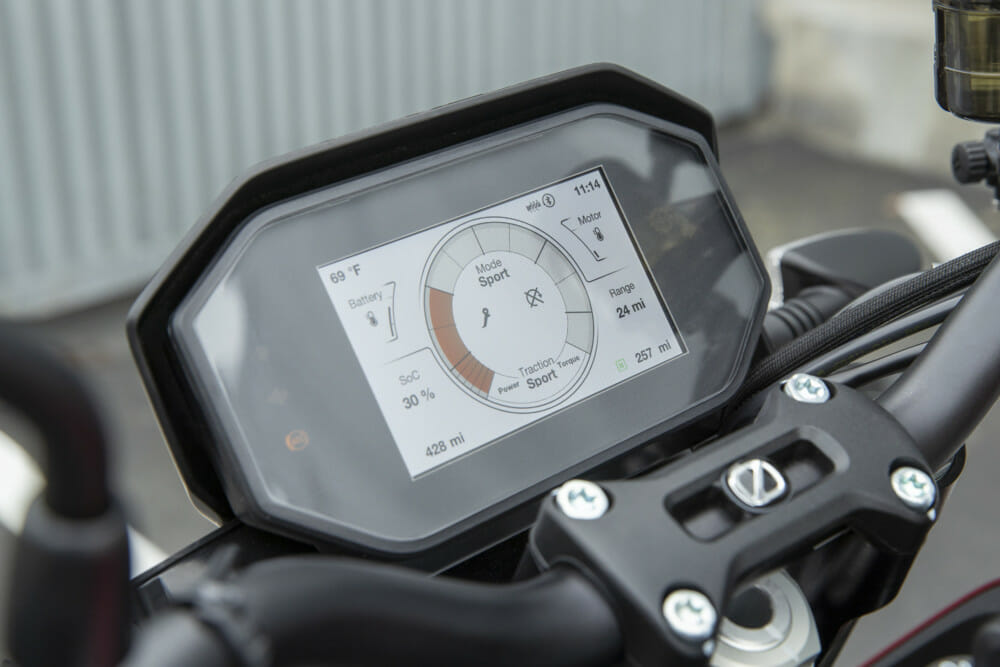
2019 Zero SR/F Mission Control
To interlock and control the array of interrelated systems that are contained in the SR/F, Zero’s engineers have now created the Cypher III operating system to act as the central hub, while delivering four pre-programmed riding modes (Street, Sport, Eco, Rain) and up to 10 programmable Custom modes which allow the rider to customize the bike’s performance via the no-cost Zero app, and TFT dash interface. Cypher III integrates the 12V system, 100V main battery charging system, battery monitoring system, controller, Bosch MSC/Motorcycle Stability Control, TFT dash, app Bluetooth connection, and cellular connectivity module. The SR/F is also the first electric motorcycle to utilize Bosch’s MSC system, a benchmark for dynamic acceleration and improved stability regardless of road surface or conditions. When combined with Cypher lIl, the MSC delivers straight-line ABS and cornering brake control, traction control, and drag torque control. Everything is seamlessly connected for easy and intuitive control that’s essentially effortless—as claimed!CN
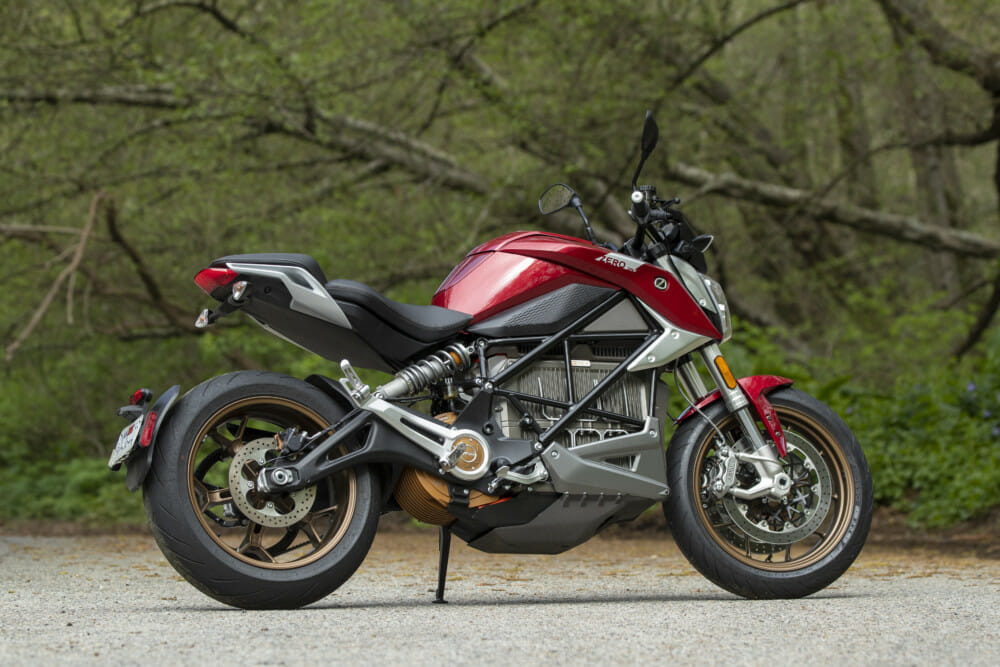
2019 Zero SR/F Specifications
| MSRP |
$18,995 SR/F Premium $20,995 |
| Power unit: |
Z-Force 75-10 enhanced thermal efficiency, passively air-cooled, interior permanent magnet AC motor |
| Controller: |
High efficiency and power dense, 900 Amp, 3-phase AC controller with regenerative deceleration |
| Powerpack: |
Z-Force Li-Ion intelligent integrated |
| Max capacity: |
14.4 kW/h |
| Normal capacity: |
12.6 kW/h |
| Charger type: |
3.0 kW, integrated (SR/F Premium: 6.0 kW/h) |
| Charge time: |
4.5 hours to 100 percent charge/4.0 hours to 95 percent (SR/F Premium: 2.5 hours, 2.0 hours to 95 percent) |
| With 6kW Rapid Charge: |
1.8 hours (100 percent charged)/1.3 hours (95% charged), (SR/F Premium 1.5 hours to 100 percent / 1.0 hour to 95 percent) |
| Drivetrain transmission: |
Clutchless direct drive |
| Final drive: |
90T / 20T, Poly Chain HTD Carbon belt |
| Front suspension: |
Showa 43 mm Big Piston Separate Function forks, with adjustable spring preload, compression and rebound damping, 4.72 in travel |
| Rear suspension: |
Showa 40 mm piston, piggy-back reservoir shock with adjustable spring preload, compression and rebound damping, 5.51 in travel |
| Front brakes: |
Bosch Advanced MSC, dual J-Juan radial four-piston calipers with radial master cylinder, dual 320 mm discs |
| Rear brake: |
Bosch Advanced MSC, J-Juan single-piston floating caliper, 240 mm disc |
| Front tire: |
Pirelli Diablo Rosso III 120/70-17 |
| Rear tire: |
Pirelli Diablo Rosso III 180/55-17 |
| Front wheel: |
3.50 x 17 in |
| Rear wheel: |
5.50 x 17 in |
| Wheelbase: |
57.1 in. |
| Seat height: |
31 in. |
| Rake: |
24.5° |
| Trail: |
3.7 in. |
| Weight: |
485 lbs. |
